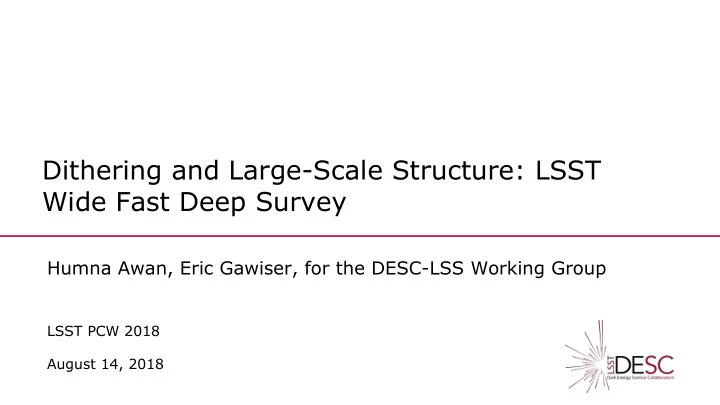

Dithering and Large-Scale Structure: LSST Wide Fast Deep Survey Humna Awan, Eric Gawiser, for the DESC-LSS Working Group LSST PCW 2018 August 14, 2018
LSS Studies Want a wide, uniform survey. Why wide? ● Systematics ~ 1/area ○ Why uniform? ● Need to correct for artificial structure induced by the observing ○ strategy: uncertainties in our corrections are a limiting factor in reducing systematic uncertainties (Awan+2016) 2
LSS Studies: Dithers Want a wide, uniform survey. Uniformity is achieved by implementing frequent, large translational ● dithers (on the scale of FOV) Awan+2016 ○ LSST Community Observing Strategy White Paper ○ Here: random offsets (in baseline WFD pointings) after every visit ● 3
LSS Studies: Survey Footprint Want a wide, uniform survey. For LSS (and any other extragalactic science): ● Need to account for Milky Way extinction ○ For good photo-zs, focus on footprint covered in all bands ○ Implement depth cuts to ensure S/N in extended sources ○ (galaxies) Science is carried out on the final survey footprint ○ Want to maximize this usable area ■ 4
WP Call: Included OpSim Outputs https://docushare.lsst.org/docushare/dsweb/Get/Document-28716 5
Wide-Fast-Deep (WFD): Current Includes high-extinction galactic anti-center Example: i-band coadded depth (after accounting for MW extinction) Total area:19,127 deg 2 (all-band footprint; no depth cut) 6
Wide-Fast-Deep (WFD): Current In some regions, extinction is high enough to disallow extragalactic science: depth cuts to discard “bad” area DESC SRD: i>26.0 for 10 yr (after accounting for MW extinction) Total area: 14,668 deg 2 7
Wide-Fast-Deep (WFD): Current ~23% area is discarded → effectively smaller WFD to work with Similar results for Year 1: ~24% area is discarded 8
Goal here: Define WFD to consist of useable footprint 9
Included OpSim Outputs https://docushare.lsst.org/docushare/dsweb/Get/Document-28716 10
Wider WFD Footprint https://docushare.lsst.org/docushare/dsweb/Get/Document-28716 11
Wider WFD Footprint Work with pontus_2002 to find the optimal footprint for WFD Minimize coverage loss following depth cuts ● 12 https://docushare.lsst.org/docushare/dsweb/Get/Document-28716
Wider WFD Footprint Work with pontus_2002 to find the optimal footprint for WFD 26,912 to 19,227 deg 2 for i>26.0 -- plenty of usable remaining area ( discarded area: ~28% of original) 13
Comparison Remaining area: 14,668 vs 19,227 deg 2 (~24% increase) 14
Extragalactic-Optimal WFD Current WFD contains high-extinction areas that should be discarded for extragalactic science Design has used stellar density to define MW exclusion - not enough ● MW dust sets stricter requirements ● Goal: design WFD to not include high-extinction regions, which would give more effective, usable footprint for extragalactic science. Further work: Run OpSim WFD cadence in optimized WFD footprint ● Deeper, more realistic sense of depth ○ Propagate through for FoM for LSS, WL and other probes. ● 15
Questions? 16
kraken_2026 https://docushare.lsst.org/docushare/dsweb/Get/Document-28715 18
Year 1 WFD: Current DESC SRD: i>24.5 for Year 1 → ~24% area is discarded 19
Year 1 Wider WFD Footprint i>24.5: 24,511 to 15,426 deg 2 ( discarded area: ~37% of original) 20
Year 1: Comparison Remaining area: 13,984 vs 15,426 deg 2 (~10% increase) 21
Recommend
More recommend